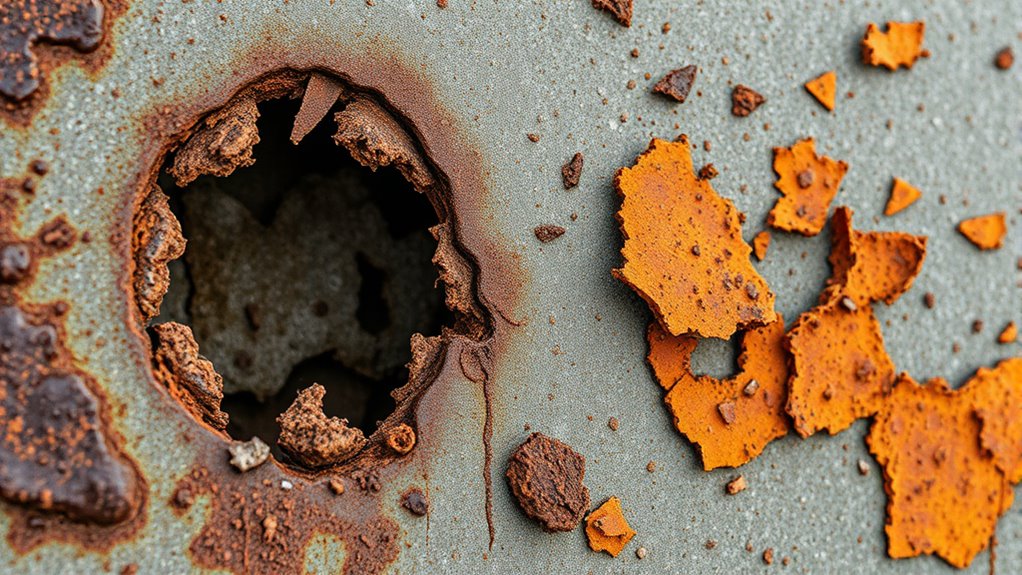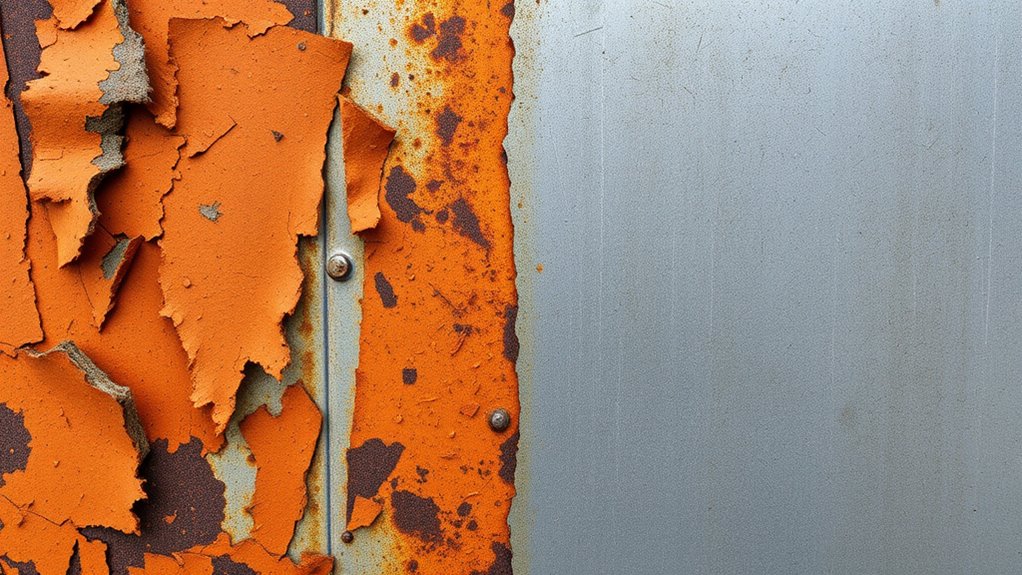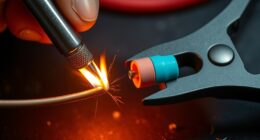Rust-through occurs when corrosion eats through metal, creating holes and weakening its strength, while surface corrosion appears as flaky discolored patches that don’t immediately threaten stability. Surface corrosion is usually superficial and easier to treat, but if ignored, it can lead to rust-through over time. Recognizing these signs early helps prevent serious damage. Keep exploring to understand the best ways to prevent and repair these common issues effectively.
Key Takeaways
- Surface corrosion appears as flaky patches or discoloration, while rust-through results in holes or breaches in the metal.
- Surface corrosion is superficial and does not immediately threaten structural integrity, unlike rust-through, which weakens the metal significantly.
- Rust-through indicates severe corrosion that compromises metal strength, whereas surface corrosion is often an early, less damaging stage.
- Prevention involves regular inspections, protective coatings, and environmental controls; repair methods differ based on corrosion severity.
- Early surface corrosion can be treated by cleaning and coating, but rust-through typically requires metal removal and welding to repair.

Understanding the difference between rust-through and surface corrosion is essential for maintaining the integrity of metal structures. When metal is exposed to moisture and oxygen, it undergoes an oxidation process that leads to corrosion. Surface corrosion, often seen as a flaky or discolored layer on the metal’s surface, is typically superficial and doesn’t immediately threaten the structural stability. It results from the initial stages of oxidation, where the metal reacts with water and oxygen, creating a thin oxide film. This layer can sometimes protect the underlying metal temporarily, but if left unchecked, it can progress. Rust-through, on the other hand, signifies a more severe level of corrosion where the metal has been compromised to the point that it has developed holes or actual breaches. This form of corrosion is dangerous because it weakens the structure’s load-bearing capacity and can lead to catastrophic failure if ignored.
To prevent surface corrosion from escalating into rust-through, you need to understand and implement effective preventive measures. Regular inspections are your first line of defense. Look for signs of discoloration, flaky patches, or pitting on the metal surface. Applying protective coatings, such as paint or sealants, forms a barrier that minimizes contact with moisture and oxygen, effectively slowing the oxidation process. Using corrosion inhibitors can also be helpful, especially in environments with high humidity or exposure to salts. These chemicals work by forming a protective layer on the metal, reducing the rate at which oxidation occurs. Additionally, controlling environmental factors—like reducing humidity, ensuring proper drainage, and avoiding standing water—can considerably decrease the likelihood of corrosion development. Incorporating aesthetic wall organization solutions can help protect exposed surfaces from environmental damage and improve overall maintenance practices.
When you notice surface corrosion, addressing it early is key. Grit blasting or wire brushing removes the flaky surface rust, and then applying a primer and paint restores the protective barrier. For more advanced corrosion, like rust-through, repairs may involve removing the compromised metal and welding new material in its place. This process ensures the structural integrity is maintained and prevents further deterioration. Remember, once rust-through has occurred, it’s difficult to reverse, so prevention is always better than repair. Regular maintenance, prompt treatment of rust spots, and using corrosion-resistant materials can save you substantial costs and extend the lifespan of your structures.
Frequently Asked Questions
How Can I Prevent Rust-Through on My Metal Surfaces?
To prevent rust-through on your metal surfaces, apply protective coatings like paint or sealants to create a barrier against moisture. Make sure to reapply these coatings regularly, especially in high-humidity areas. Conduct regular inspections to catch early signs of corrosion before it worsens. Address any chips or damages promptly, and consider using rust inhibitors for added protection. Consistent maintenance keeps your metal surfaces durable and rust-free longer.
What Are the Cost Differences Between Treating Surface Corrosion and Rust-Through?
Getting ahead of the game, you’ll find surface corrosion treatment costs less than rust-through repairs. The cost comparison shows that addressing surface issues early keeps expenses down, while rust-through treatment can skyrocket due to extensive repairs and material costs. fundamentally, treating surface corrosion is like putting a band-aid on a small wound, whereas fixing rust-through is more like rebuilding a part of your structure. Prevention saves money and hassle in the long run.
Does Rust-Through Always Lead to Structural Failure?
Rust-through doesn’t always cause immediate structural failure, but it signals advanced rust progression that weakens your metal over time. If left untreated, this corrosion can compromise your structural integrity, increasing the risk of failure. You should regularly inspect for rust-through signs and address them promptly to prevent deterioration. Ignoring rust-through may lead to costly repairs or safety hazards, so proactive maintenance is essential for preserving your structure’s strength.
Are Certain Metals More Resistant to Rust-Through Than Others?
Think of metals as brave knights with different armor strengths. Some, like stainless steel or aluminum, boast higher corrosion resistance thanks to their unique metal composition. These materials stand firmer against rust-through, resisting damage that could compromise their strength. So, yes, certain metals are more resistant to rust-through than others, making them your best allies in harsh environments where durability matters most.
How Long Does It Typically Take for Surface Corrosion to Develop Into Rust-Through?
Surface corrosion can take anywhere from months to years to develop into rust-through, depending on environmental factors like humidity, salt exposure, and temperature. If you have a paint coating, it slows the process, but once that coating deteriorates or cracks, moisture reaches the metal, accelerating rust-through. Regular inspections and maintenance are key to catching early signs of surface corrosion before it penetrates deeper, especially in harsh environments.
Conclusion
So, now you know the difference between rust-through and surface corrosion, but what’s next? Will you catch the early signs before it’s too late? The choice is yours—understand the risks, inspect regularly, and act quickly. One small oversight could mean the difference between a simple fix and a costly repair. Are you prepared to spot the warning signs before rust takes over completely? The next step is yours to take.









